HOUSEHOLDS
Finding the Beach House Where I Still Live After 55 Years
By Pat Holm
Pete and I were renting a little cabin a couple of blocks from the Boston Harbor Marina when John, who was visiting from Seattle, and I decided to go exploring.
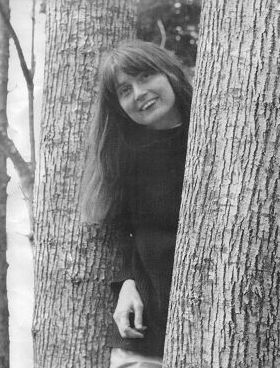
I turned the car toward the water onto Giles Road from Boston Harbor Road. The water couldn’t be far away. In the back of my mind was the prospect of a secret kiss in a secluded spot away from the look of others. Trees hid what could be a view. Then I spotted a road turning down closer to the shoreline. I had always loved water. My father was a chauffeur who worked for rich people that lived on Lake Minnetonka, Minnesota. My family got to live in a small cabin near the lake. That meant swimming on hot days for us kids.
The road led us to a few parking spaces off a dirt driveway that made a loop back up to Giles Road. There were no vehicles, so I decided to park the car. We got out and looked. No one seemed to be around. “Let’s try to get down to the water,” John said, pointing to the rather wide path disappearing down the hill. He ran ahead, I was close behind. What we found were two houses connected by a wooden deck overlooking Budd Inlet.
They were small old wooden houses, cabins really, hugging the bank. We quickly assessed that no one was there, but it looked like one house had people living in it. The windows were ajar revealing a cup, a half empty glass, and a soda pop bottle. A couple more roofs appeared to the left of these two cabins. I found out later that these four cabins were all built at the same time, about 1929, by a group of four family friends in Centralia. The designs were all very similar. Apparently many men were out of work back then, so the cost of building was very cheap. Inside all of the houses was the same wainscoting wood on the walls. The outsides were all cedar planking. The families came to stay in these cabins in the summer. Recently, a Mr. Noreen had purchased two of them and was renting one out.
Huge madrona trees overhung the bank above a beach, the fir trees so tall you had to turn your head and look up to see the tops. It was only much later that I learned the names of those trees. Madrona trees signal you are close to saltwater, their branches reach out beyond the bank seeking the sun.
It was spring of 1964 and the leaves on the trees were still young, freshly green. The smell of the saltwater lingered in the air. The morning sun, still hiding in the east, was not yet visible through the many trees. This enclave of four cabins was just waiting to hold the lives of my family and friends. These four beach cabins stood wanting to be found and turned into a beatnik haven of music and art. In a few years, Keith and Marty and four others would move into the second cabin. Keith was from Bellingham, the others were transplants from Michigan. Later, a sculptor and her lover would move in, and much later, after a few more hippies tried out living there, a Mansion Glass artist, Bill, would move into the cabin at the north end. He is still there. Then after long-time neighbor Bob died, the house next to me was for sale and Bill’s buisness partner Tom bought it. Tom’s son, an award-winning filmmaker, is living there now. This is still an artist colony and I hope can remain so.
John and I set out to explore the house to the right of a short stairway. Looking into a window, we saw no furniture inside. We went down another rickety stairway finding a dirt area where we could walk under the deck to the far side and get on the deck by climbing up a short, steep path. Once on the deck, we peered through the small-paned windows which looked out onto the bay below. Those windows were so beautiful, with over 20 small panes each surrounded by cedar sash, painted orange. They fronted the whole 25-foot living room.
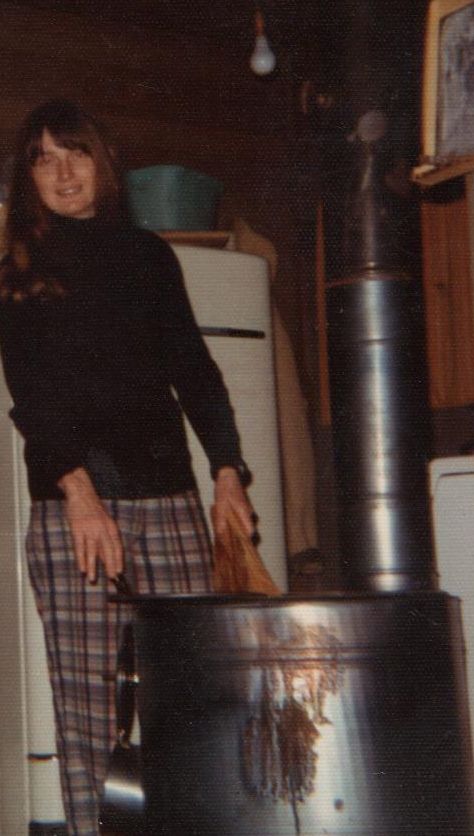
Little did I know these windows would offer no insulation from the cold, and would later become responsible for the arthritis that set into my hands one snowy, icy, treacherous winter. At the time, I never thought how windows would let in the cold. The arthritis came in 1968 during the first winter my daughter Kirsten and I spent by ourselves in this drafty house. Pete had recently moved out. Frames full of cracks, the ill-fitting glass let in blasts of icy wind. It was almost impossible to heat the whole house with just the fireplace in the living room and an old wood cook stove in the kitchen. With fires going constantly in both, it was bearable. But after Pete left in August of 1968, that winter without him to help with gathering wood, it was freezing, and there just wasn’t enough firewood available.
But back in 1964, springtime, I wasn’t thinking about heat. I was thinking, “This is absolutely beautiful, a house on the water and no one lives here. I must find out more.” John and I, fueled by our curiosity, prowled around behind the house, which was built up against another six-foot bank just allowing us enough access to see a bathtub in a corner. We wanted to see more, but it was too overgrown back there and not enough room to squeeze a body further behind the house. Now I was intrigued. I forgot my desire for stolen kisses and concentrated on finding the owner of the empty cabin. The two-story structure was rickety and empty, but maybe it would be possible to rent. How to find the owner?
All four cabins here were built on wooden posts, no proper foundations. You could see the sloping ground under them. The two other cabins were only visited in the summer by their owners. After a month or so of searching and asking, I tracked down the owner. I moved into the house with Pete and Kirsten for $75 a month rent with a contract to buy.
After moving into the Giles Road house overlooking the inlet in the spring of 1964 I was in heaven. This old house had a fireplace and a view of the water—the two things I had wanted most when I was growing up. When I was a girl we lived a block and a half from Lake Minnetonka, but my girlfriend lived right on the lake and their house had a fireplace. My dollhouse had a fireplace, but the box-like house our family lived in did not. Now in 1964, I had a fireplace, the bay, and for me, upward mobility, for only $75 a month.
Gathering wood and making fires in my fireplace gave me joy. Because our house is on the east side of the bay surrounded by tall trees, the mornings even in the summer, are cool and damp. The sun doesn’t come around until noon. Often, the sun waits until one o’clock to start heating up the sandy, barnacled beach below. Fires are often necessary even in the summer. That first spring, I loved going out in the morning to find small twigs and branches to start a fire in my fireplace. The smells of the earth oozed out and I inhaled their perfume with pleasure.
I still walk outside and look for small wood debris to start my fires. I smell the salty air rising from the beach and the damp duff from the forest floor. I am near the earth, part of the earth, and I feel this is where I belong. I look closely for bits and pieces of dried twigs and branches under the trees on the hillside above. After gathering an armload of starter wood, I bring it inside to start my morning fire. A box of “strike-anywhere” matches is on the floor beside the fireplace. I loosely crumple last night’s Olympian and place it in the back of the fireplace. I strike a match on the brick and light the newspaper. In turn, it ignites the brown pine needles which begin to pop. Bursts of resin escape and orange-yellow flames give me the first glow of warmth. I have succeeded in gathering just the right amount of dry pine-needle twigs to get a small blaze going. After adding a few bigger pieces of wood stacked nearby, I make my morning coffee, sit and contemplate the crackling warmth from my very own hearth.
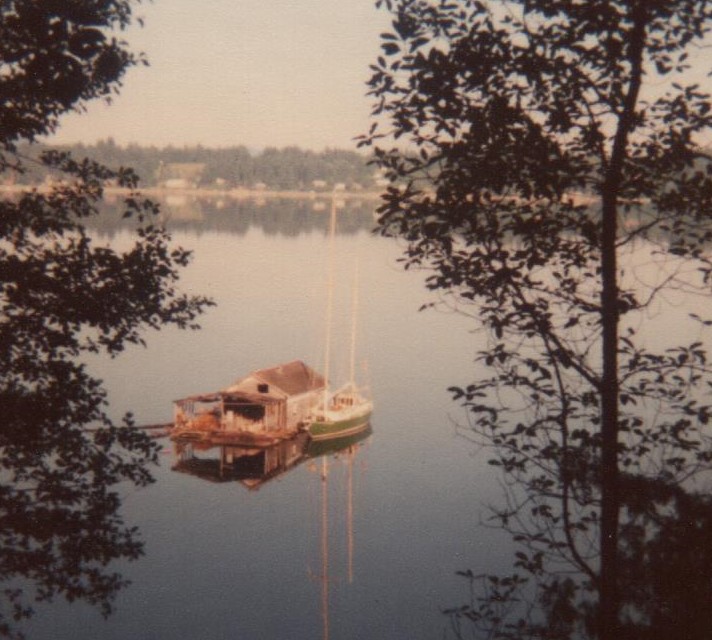
I have been on this land now over 55 years and never tire of gathering firewood or looking at the expanse of water before me. Outside my windows is Budd Bay. After moving here, I had to learn the difference between saltwater and freshwater environments. I was raised near freshwater. Tides were new to me and caused me to lose my dinghy a few times before I remembered to drag it up and secure it on the beach.
Tides are tricky. They can be fast or slow. Recently, I went down to the dock and saw the water moving swiftly. As I watched, I could tell how fast the tide was moving by the slight scum sliding over the stones below. The tide doesn’t always move so fast. Sometimes it’s hard to tell which direction it’s moving. This night was different, the tide was swift. But still, I looked out to see which way the boats were hanging off their moorings. Yes, the tide was definitely going out. When you are swimming or boating it’s always important to know which way the tide is moving so you don’t get caught without having enough strength to get back to your starting place.
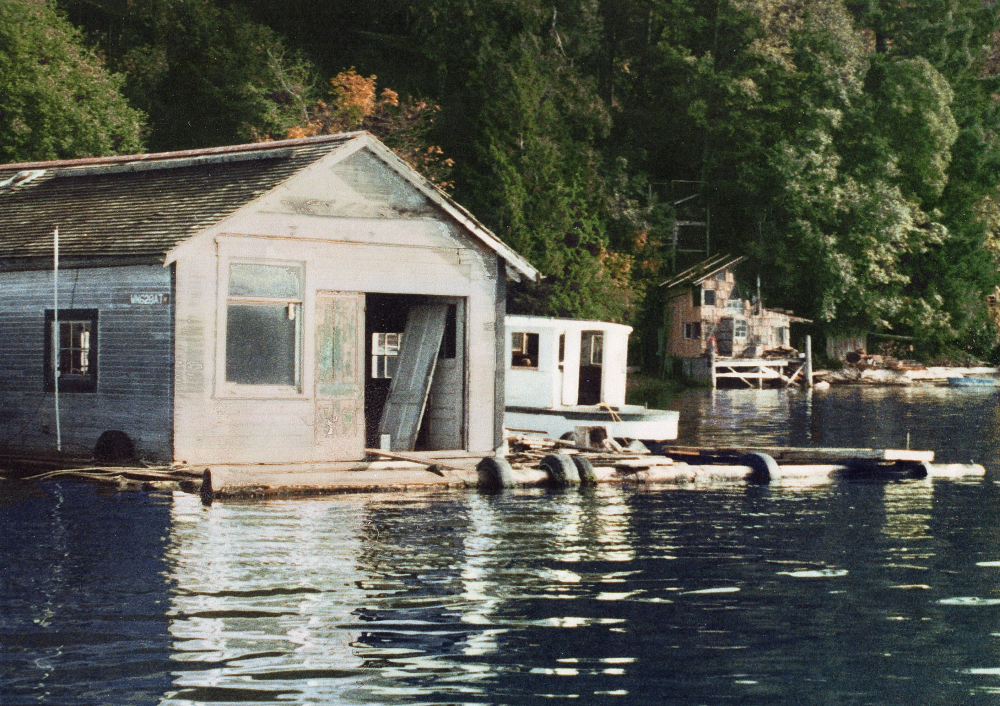
I used to wish I could have both the sunrise and the sunset, but I know that unless you are located on the southern end of an island, it’s impossible to have both. I’m content with the slowly setting sun. The evening glow, moving across the ceiling and walls, illuminates the house with a patina of memories.
In 1969, I moved to Seattle to go back to college and get my fifth year, now required to teach English again. Pete divorced me in 1968 and then re-married. He and Claire moved into the house at the north end of Giles Road. Pete and I had purchased the two cabins that were joined together by a deck for $17,000. We were making payments with a lease-option deal. I needed money to go back to school, so I gave the houses back to Pete in exchange for $2,000. I didn’t know that houses gained value each year. So I calculated what my share of the payments had been and I was happy with the result. But I was really sad when Pete decided to sell the two houses for $35,000 soon after I left for Seattle. Pete and Claire took the money, borrowed a big barge, and moved to Waldron Island. I no longer had title to my precious houses.
With amazing luck, though, the fourth cabin was on the market in 1971. I was with Steve at that time and I showed him the cabin that was for sale at the southern end of the enclave. He was delighted with it, too. We decided to buy it together and move back to my special place. This house was even better because it wasn’t quite so close to the edge of the bank as the original two cabins.
It still had the charm and ambience of the other two. It didn’t have a fireplace but I had a state job and I used that money to build one as soon as we moved in. We built a deck, too, to overlook the bay and I go swimming when I can. I put in french doors in the kitchen that opened out to all the beauty around.
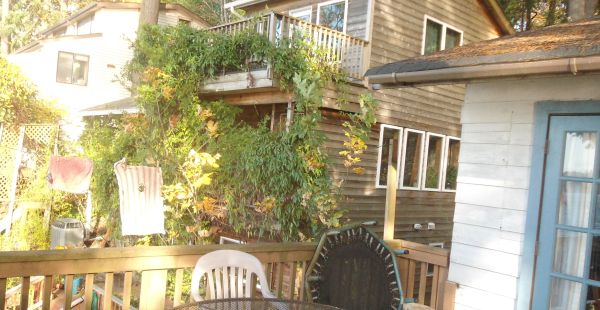
We encourage readers to contact us with comments and corrections. Disclaimer
